
A 2016 photo of a Ukrainian Air Force MiG-29 fighter jet at a military airbase in Vasylkiv village, some 30 kilometers outside Kyiv. Danil Shamkin/NurPhoto via Getty Images
Can Ukraine Really Use Donated Fighter Jets? That Depends
After EU says it will send some aircraft to Ukraine, a retired U.S. fighter chief explains how that might work.
Perhaps the most eye-popping of today’s pledges to ship weapons to the Ukrainian military was the European Union’s announcement that it would soon send fighter jets. Would Ukrainian pilots really be able to jump in a donated jet and fly into combat?
Herbert “Hawk” Carlisle says sure, if it’s a type they already know how to fly.
“It really would not be a big step, going from a Ukrainian MiG-29 to a Polish MiG-29,” said Carlisle, a retired general who oversaw U.S. Air Force fighter jets as head of Air Combat Command.
The EU official who made Sunday’s announcement said he understands that the Ukrainian Air Force has no time to get up to speed on unfamiliar aircraft.
“They need the kind of fighters…that the Ukrainian force is able to operate,” EU policy chief Josep Borrell said. “We know what kind of planes, and some member states have these kinds of planes.” Borrell did not say what kinds those were.
But according to the Flight International 2022 World Air Forces database, the Ukrainian air force flies Soviet-made MiG-29s and three types of Sukhoi jets. Three NATO nations, Poland, Slovakia, and Bulgaria, also fly the MiG-29, a twin-engine fighter jet developed in the 1970s. Bulgaria also flies the Su-25, a close-air support jet also flown by Ukraine.
Since Ukraine already flies the MiG-29, its Air Force pilots could immediately fly MiG-29s flown by other countries without any major training, Carlisle said. Pilots typically must go through a training course before climbing into the cockpit of a new type of jet.
“It's not like driving a Chevy and then driving a Dodge,” Carlisle said. It takes a bit to transition airplanes between makers, as well as within makers, if it's a different type of airplane.”
In the late 1980s, Carlise, who is now the CEO of the National Defense Industrial Association, flew MiG fighters as part of a U.S. Air Force squadron that tested Soviet warplanes secretly acquired by the U.S. government.
The F-16, to name another plane popular with NATO militaries, would not be of immediate use. Even though there are thousands of U.S. made F-16s flying in the United States and around the world, it would take time to familiarize the Ukrainans with American equipment.
“The U.S. builds airplanes significantly different than the Russians do,” Carlisle said. “Going to a U.S. fighter is a big step.”
Ukrainian pilots would also have to train to fly the planes in advance, which would take time, something that Ukraine doesn’t have as Russian forces advance toward Kyiv.
“They would have to get checked out in the airplane and understand, you know, all the operating limits, all the weapons systems, [and] how to handle the airplane,” Carlisle said. That's a pretty big step—that can't be done kind of a drop of a hat type thing.”
Also, the U.S. State Department would need to approve the transfer of any F-16s flown by NATO allies to Ukraine.
But Carlisle suggested that there were plenty of other U.S. weapons that could help Ukraine prevent Russian jets and helicopters from flying around uncontested.
“Whatever we could give up to counter [Russia’s] air superiority would be a huge advantage,” he said.
Electric jammers and anti-tank weapons would also help the Ukrainians, Carlisle said.
“Whatever you can do to interrupt their information or degrade their electronic capability that can be advantaged.







